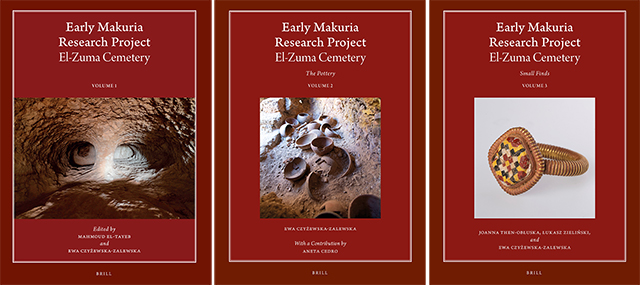A three-volume monograph on the cemetery in El-Zuma (Sudan) has been published by Brill and is available in Open Access. The research was conducted by an expedition from the Polish Centre of Mediterranean Archaeology of the University of Warsaw (PCMA UW) and the National Corporation of Antiquities and Museums in Khartoum directed by Assoc. Prof. Mahmoud El-Tayeb from PCMA UW.
El-Zuma is situated on the right bank of the Nile, between the third and fourth cataracts. The site was inscribed on the UNESCO World Heritage List due to the unique tumuli from the 5th–6th centuries located there. The research on these tombs was carried out as part of the Early Makuria Research Project, led by Assoc. Prof. El-Tayeb.
Until recently, the early Makuria period that preceded the creation of Christian kingdoms in Nubia was poorly understood. Therefore, the results of excavations in almost thirty tumulus tombs in El-Zuma where representatives of various social classes were buried offer a significant contribution to the current knowledge on this subject. The publication has been prepared by the project team, including employees and associates of PCMA UW. It was published as part of Harvard Egyptological Studies, a well-established series at the Brill publishing house.
The publication of the monograph was co-financed by the Nubian Archaeological Development Organization Qatar-Sudan Archaeological Project (QSAP) grant and by the University of Warsaw and the IDUB program.
All three volumes are available on the Brill website.
El-Tayeb, M., Czyżewska-Zalewska, E., Iwaszczuk, U., Juchniewicz, J., Kowarska, Z., Kozieradzka-Ogunmakin, I., Lenarczyk, S., Mahler, R., Skowrońska-Zych, E., Cedro, A., Then-Obłuska, J., & Zieliński, Ł. (2021). Early Makuria Research Project. El-Zuma Cemetery (3-vol. set). Leiden, The Netherlands: Brill. doi: https://doi.org/10.1163/9789004433755
- Volume I, edited by Mahmoud El-Tayeb and Ewa Czyżewska-Zalewska, is devoted to the exploration of tombs (Mahmoud El-Tayeb, Ewa Czyżewska-Zalewska and Ewa Skowrońska), with a section on documentation methods (Szymon Lenarczyk, Zofia Kowarska and Magdalena Antos). It also discusses the results of bioarchaeological research on human (Robert Mahler, Iwona Kozieradzka-Ogunmakin, Abagail Breidenstein) and animal (Urszula Iwaszczuk) remains, which shed light on burial traditions in the context of the economic background of the site and the whole region. It also presents plans of site management and presentation in the form of an archaeological park (Jolanta Juchniewicz, Mahmoud El-Tayeb).
- Volume II, by Ewa Czyżewska-Zalewska, contains an analysis of the pottery found in the tumuli. It discusses its typological and technological classification, types of ceramic mass and functions of the vessels. It also includes a separate section on clay oil lamps by Aneta Cedro.
- Volume III collects studies on small finds. It opens with a chapter on jewellery and personal ornaments by Joanna Then-Obłuska. The second part, by Łukasz Zieliński and Ewa Czyżewska-Zalewska, presents metal objects: weaponry, personal accessories and elements of grave equipment.
Mahmoud el-Tayeb is an archaeologist and Nubiologist. He heads the PCMA UW Research Centre in Sudan. For almost 40 years, he has been managing research projects in Sudan. He is a member of Sudanese and international scientific societies. For many years he lectured at the Institute of Archeology of the University of Warsaw. Author of numerous scientific publications, in 2013, he received a postdoctoral degree for his dissertation Burial Traditions in Nubian Early Makuria.
Read more about El-Zuma.

